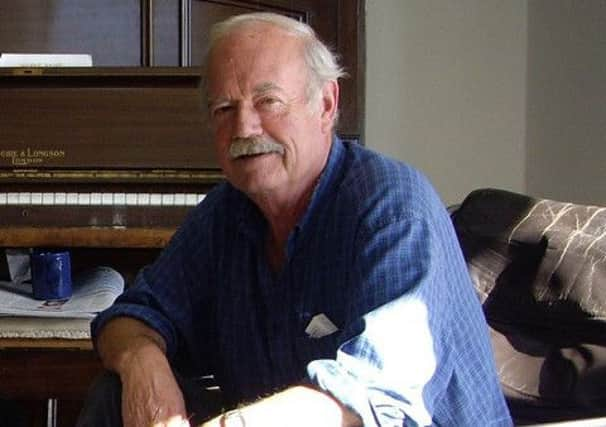Obituary: Andrew Nicoll, architect and jazz musician


Andrew Nicoll, who has died suffering from Alzheimer’s Disease, was the co-founder of one of Scotland’s most successful architectural practices, a campaigner strongly committed to the regeneration of Dundee and the surrounding area, and – in his spare time – a lifelong jazz enthusiast and musician, who for decades ran memorable jazz nights and events in Broughty Ferry, where he lived with his wife Dorothy and their family for almost 50 years, and where he based his architectural partnership, Nicoll Russell Studios.
As a young architect in London in the early 1960s, he worked with cutting-edge architects including Powell & Moya, the designers of the landmark Festival Of Britain Skylon, and Denys Lasdun, architect of the National Theatre on the South Bank. He also met the legendary Team 4 – Su Brumwell, Wendy Cheesman, Richard Rodgers and Norman Foster – and was offered a chance to join their new partnership, which he declined because of the financial risk involved; as his daughter Hilary put it in her blog and exhibition The Museum Of Dad, seen at Woodend Barn in Banchory earlier this year, “no regrets were ever expressed.”
Advertisement
Hide AdAdvertisement
Hide AdAndrew Nicoll returned to Dundee in 1966 to work with local architects Robbie and Wellwood, forming a close working relationship with the young designer Richard Russell; and in 1982, as they completed work on the new Dundee Rep building in Tay Square, Dundee, he and Ric Russell launched Nicoll Russell Studios, based in a spare room at Nicoll’s family home, a partnership that went on to win RIBA awards for buildings including Dundee’s Sheriff Courts, the Grianan Building at Dundee Technology Park, the Home Superclub in Leicester Square, London, and the Byre Theatre at St. Andrews, and is still one of Scotland’s leading practices. “Andrew was the absolute linchpin of our first 20 years’ work at Nicoll Russell,” says Ric Russell, “and without him, absolutely none of it would have happened – no contacts, no contracts, no money, and none of the projects that helped to establish the company. He was quite an alternative kind of guy, very gentle but also very solid and supportive, with a wonderful optimism about him – almost to the point of stubbornness. Whenever we ran into difficulties, he’d say, ‘there’ll be a way to get round this.’ And usually there was.”
Andrew Strachan Nicoll was born in Carnoustie in 1940, the son of David Duncan Nicoll, who was killed in action in Germany in 1945, and Helen Nicoll, nee Kidd, who in the 1930s had been one of the first-female graduates of Duncan of Jordanstone art college in Dundee. He grew up as the middle child of five, raised in Carnoustie, and went to Arbroath High School before studying architecture at Duncan of Jordanstone. He graduated in 1963, and married Dorothy Dickson in December of that year; but after three exciting years in London – during which Andrew was able to feed his jazz obsession in clubs such as Ronnie Scott’s – the couple decided to return to Dundee; they already had one child, Hilary, born in 1966, and were expecting another.
Back in Broughty Ferry, the Nicolls’ life fell into the creative pattern that was to last for the next 40 years, as Andrew worked hard at Robbie and Wellwood, often supporting younger designers, and Dorothy raised their three children; Duncan was born in 1967, and their second daughter Julia in 1971. And beyond work and family, there was always the jazz, and the parties; Andrew played trumpet and trombone, scored some astonishing successes in attracting leading musicians to his Broughty Ferry club nights, and often kept open house for friends, colleagues, and everyone who shared his creative passions. After the launch of Nicoll Russell in 1982, Dorothy began to play a major role in the business, acting as secretary and administrator while dealing with the difficulties of having a busy architectural partnership in her family home; and she continued to work with her husband and his partners until her retirement in 1999.
In 2002, Andrew Nicoll also retired from Nicoll Russell; and for the first five years of his retirement, he remained active in organisations concerned with the built environment of Dundee and Angus, its conservation and regeneration. He worked with Dundee Civic Trust, the Broughty Ferry Development Trust and the board of the Mills Observatory, living to see Dundee become the resurgent City of Design it is today; and even after his illness began to take hold, he retained an interest in many of these projects, as well as in his family and friends.
As a practical architect, Andrew Nicoll left a powerful mark on the landscape of Scotland, helping to enable and create late 20th century buildings that combine boldness with a profound sensitivity to the urban fabric of towns like Dundee, St Andrews, Arbroath; as a man, he is remembered with love for his solidity, his warmth, and his alternative approach to the world. “At heart, Andrew was a jazzer,” says Ric Russell. “He believed in creativity, and in improvisation, and his whole life reflected that.”
Andrew Nicoll is survived by his wife Dorothy, his children Hilary, Duncan and Julie, and five much-loved grandchildren; and by a generation of architects now working in a landscape partly shaped, and much enriched, by his presence, his work, and his inspiration, over the last 50 years.
Hilary Nicoll’s The Museum Of Dad, featuring a journey around her father’s study during his illness, can be visited online at themuseumofdad.tumblr.com.
JOYCE MCMILLAN